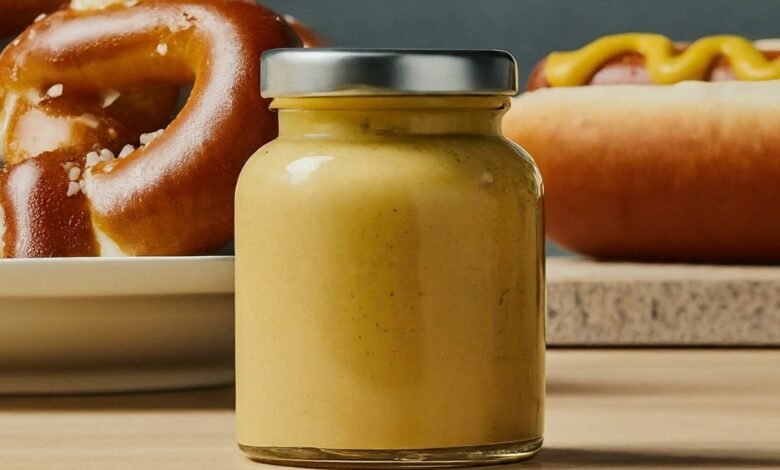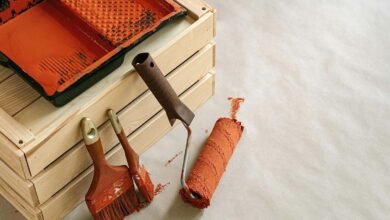
Tangy and spicy, mustard jazzes up everything from hot dogs and pretzels to sandwiches and charcuterie boards. This zesty, multipurpose condiment is the unsung hero bringing big flavor to countless dishes.
But, mustard can overstay its welcome if forgotten too long. If you’ve ever eyed a crusty or dusty topped mustard bottle with suspicion, this guide is for you.
No more opening and sniffing jars repeatedly – we’re demystifying mustard’s shelf life so you can confidently enjoy without worry!
Does Mustard Go Bad?
The simple answer: Yes. Mustard does go bad, eventually.
But don’t start tossing out jars yet! Quality mustard stored properly lasts surprisingly long. Let’s dig into specifics!
All mustards contain three key ingredients making them stable and shelf-stable up to a point:
1. Vinegar (or another acid like wine, verjus, etc.)
2. Salt
3. Mustard seed and/or powder
This triple combination prevents microbial growth by lowering pH through acidification. This makes it an inhospitable for bacteria, making mustard well-preserved.
That said, air exposure over time causes quality degradation through oxidation, ingredient separation, moisture loss, and off-flavors. That brilliant yellow hues in some mustards can fade, seeds sink, vinegar bite fades to bland blandness.
It can take months to years before these changes affect overall product quality – and even longer to render mustard legitimately spoiled or inedible.
So while mustard has no true “expiration” date, its shelf-life isn’t indefinite either.
Let’s explore the typical shelf life ranges of mustard.
How Long Does Mustard Last?
Like many condiments, the longevity of mustard depends on three key factors:
1. The type of mustard: A vinegar-heavy prepared yellow mustard has a longer lifespan than creamy flavored versions.
2. Opened mustard: Unopened jars keep longer than opened ones.
3. How it’s stored: Refrigeration dramatically extends shelf life versus warm pantry storage.
With those variables in mind, here are some general mustard shelf life guidelines to follow:
Unopened Bottles
Yellow Mustard: 2-3 years (pantry), 3+ years (fridge)
Dijon, Grained/Seeded, Flavored Mustards: 1.5-2 years (pantry), 2+ years (fridge)
Opened Bottles
Yellow Mustard: 1-2 years (pantry), 2+ years (fridge)
Dijon, Grained, Dry Mustards: 6-12 months (pantry), 18-24 months (fridge)
Creamy, Sweetened, Low-Acid: 4-6 months (fridge only)
Key Takeaways:
- Refrigeration greatly lengthens opened mustard’s prime quality window, nearly doubling usable life.
- Unopened mustard keeps much longer than opened.
- Simple yellow mustard outlasts fancy specialty flavors
- Low-acid/creamy types of mustard have much shorter fridge lives.
That was a lot of numbers, so let’s break it down further by mustard type.
Yellow Mustard’s Long, Long Shelf Life
We’ll start with the OG classic jarred mustard gracing ball parks and cookout condiment caddies everywhere. Your trusty bottle of yellow mustard can last years past any “best by” dates.
- Unopened yellow mustard remains safe 2-3 years past any printed dates, sometimes longer if refrigerated.
- Opened jars maintain quality 1-2 years at room temp, 2+ years refrigerated.
How can this be? Its resistance to spoilage lies within its ingredients.
Yellow mustard is made mostly with ground mustard seed, vinegar, salt, and the spice turmeric to give it its sunny yellow color. All of these ingredients has antimicrobial properties.
Mustard seeds contain powerful antimicrobial compounds including glucosinolates, and their by products – isothiocyanates (ITCs). (1, 2) Used for over 4000 years in India, yellow mustard’s, turmeric is rich in another potent antimicrobial compound called curcumin (3).
Often used as a natural disinfectant, several studies have also shown that the acetic acid gives vinegar is anti-fungal, anti-viral and anti-bacterial properties (5, 6). And salt has been used as a natural food preservative around the world for centuries (4).
This vibrant condiment simply doesn’t provide an environment conducive to microbial spoilage.
So don’t freak over a dusty open bottle of French’s stashed away. As long as it looks and smells normal, squirt away months or years after opening.
Just store it properly:
- Keep opened mustard chilled and sealed after each use to prevent oxidation and drying.’
- For unopened backups, a cool pantry is fine short-term.
- Refrigerate if storing longer than 6 months.
Doing so extends yellow mustard’s quality even further – likely to the five-year mark or beyond before requiring safe disposal.
Dijon and Seeded (Grained) Mustards
Although not basically immortal like yellow mustard, grainy preparations like Dijon and whole-grain seeded mustards stored properly still remain edible surprisingly long thanks to vinegar preservation.
For Unopened Dijon/grainy mustard jars, expect peak freshness:
- Pantry storage: 18-24 months
- Refrigerated: 2+ years
For Opened Dijon/grainy mustard jars:
- Room temp: 6-12 months
- Refrigerated: 12-24 months
The vinegar’s acidity coupled with lower moisture and higher sodium levels create unfavorable growth conditions for any potential pathogens – while still allowing diverse flavors from spices, wine and unique mustard varieties to shine.
You may notice seed settling, moisture loss, concentrating flavors, and slight color dulling as aged jars decline over time. But the mustard will remain safe past printed dates.
Just don’t let untouched opened jars sit around more than a year after cracking the lid. The mustard won’t hurt you, but it can lose its signature tangy zip.
What About Fancy Flavored Mustards?
Craft or flavored varieties like honey mustard, ale mustard, herb mustards and the like can be a bit trickier, boasting shorter but still respectable shelf lives.
They typically contain low or no vinegar. But antioxidants from spices, wine, beer or spirits along with moderate sugar levels provide preservation.
Fancy flavored mustards will last:
• Unopened, stored properly: 12-18 months tops
• Opened, refrigerated: 8-12 months
• Opened, room temp: 3-6 months
Although not vinegar bombs, most flavored mustards still contain enough acid and salt to inhibit rapid spoilage – just not at the Epic preservation levels of classic yellow mustard or stoneground Dijon.
So savor that fancy mostaza whiskey honey bliss relatively quickly within a year of opening and refrigerate for max freshness.
If storing at room temp, prioritize finishing within 6 months for best flavor.
How to Store Mustard for Longevity
No matter the mustard type, one constant is key: always refrigerate after opening!
Cold temperatures below 40°F inhibit moisture loss, oxidation, and bacterial growth to extend mustard’s longevity dramatically. Unrefrigerated opened mustard quickly loses quality and spoils far sooner.
Best practices for prolonging mustard freshness include:
- Squeeze out excess air before sealing: Air is the enemy depleting vibrant color and flavor.
- Opt for glass jars: Plastic allows more air permeability accelerating quality decline.
- Keep refrigerated but don’t freeze: Freezing degrades texture.
- When unopened, store it cool and dark: A refrigerator or a cool, dark pantry or cabinet work well.
Simple steps like these ensure you’ll squeeze out every delicious drop from each jar before it spoils. Mustard may not enjoy literal immortality, but quality lasts months or years with proper care!
Signs Your Mustard Has Gone Bad
Even the most robust mustard can turn, sadly. Keep an eye out for these clear signs it’s past its prime:
• Mold Growth: Green, black, white, or pink fuzz or film means toss it now!
• Bulging or Leaking: Cracks, seepage, or misshapen lids from internal gas buildup indicate bacterial spoilage.
• Bad Smells: An off, rotten, or drastically diminished aroma likely signals spoiled condiment.
• Extreme Discoloration: Significant graying, browning, or just an unnatural loss of vibrancy.
• Excessive Dryness: If the seeds and powder have turned to an inedible crispy texture, it’s a goner.
• Liquid Separation: A bit is normal in some mustards, but excessive puddling usually accompanies spoilage.
• Bad Taste: If it tastes wrong, inedible, or makes you recoil, just toss it out!
The moral? Use your senses – eyes, nose, taste – to judge. If mustard seems off in multiple ways, it likely spoiled and isn’t worth risking foodborne illness over.
How to Revive Bland, Dry Mustard
If your unopened mustard runs a bit dry and flavorless after extended pantry life, don’t throw it out! Easy remedies can resurrect almost-stale mustard back to full-bodied glory.
Just follow these simple 5 tips to reinvigorate opened dried-out or dull mustard:
- Add vinegar or wine: A splash of acid refreshes signature tanginess.
- Mix in dry mustard powder: This boosts up mustardy flavor.
- Grate in fresh garlic or horseradish: Natural pungency and heat wake it up.
- Shake or whisk to re-emulsify: This re-incorporates separated solids and liquids.
- Season with salt, spices, etc.: Customizable flavor boosts to your liking!
Don’t be afraid to experiment and wake up lackluster mustard with ingredients you enjoy. Not just vinegar but hot sauces, beer, chili sauce, even jam can add zest.
💡 The key: reintroducing missing liquids, salt, heat and acid through aromatics and flavorings. Stale never tasted so reborn!
Should You Freeze Mustard?
Unlike some condiments, freezing mustard does more harm than good to texture. That’s because the high liquid content turns icy and crystallizes, becoming grainy and spongey upon thawing.
The ingredients also separate irreversibly in the freeze/thaw cycle. So despite technically remaining food-safe almost indefinitely, defrosted mustard loses its signature thick, emulsified texture.
That said, if long-term pantry storage is your goal, freezing works okay as a last resort. Just know you’ll need to vigorously re-whisk and possibly add a few ingredients post-thaw. The texture won’t be quite the same though.
For most households, proper refrigerated storage eliminates need for ever freezing in the first place. Mustard already lasts so long chilled, only bulk purchasers like restaurants should consider freezing extra jars.
So stick to fridge storage for optimum opened mustard freshness rather than gambling texture quality in the freezer.
Can You Revive Moldy Mustard?
Don’t bother – mustard gone moldy should be tossed. While tempting to try scraping surface mold off, fungi have insidious roots penetrating inedibly deep. A little mold equals full-jar contamination.
The same irreversible rule applies to leaking, bulging or otherwise clearly spoiled mustard. Once pathogens take over through improper storage, spores spread everywhere and no amount of boiling or additions can restore safety.
So if you spot any major mold development, leaks, or long-term sitting at warm temps, mustard’s done – dump it immediately.
Homemade Mustard’s Shorter Lifespan
One final caveat. Home-prepared mustard, whether a trendy DIY recipe or grandma’s secret blend, has a drastically shorter shelf life than commercial jars.
With zero preservatives to help beyond salt and vinegar, these small batches begin losing quality within a month or so at room temp.
Homemade mustard will last:
- Refrigerated: 3-4 months
- Not refrigerated: 2-3 weeks
So while fun to craft, consume homemade mustard fairly quickly for premium flavor. Leave extended storage to commercially produced varieties designed to last months or years.
Will You Keep Mustarding On?
There you have it – the full uncensored truth on mustard’s shelf life, straight from the seed’s mouth! No more dumping perfectly safe condiment money down the drain based on overly conservative dates.
Quality unopened mustard, turns out, lasts shockingly long when stored properly.
With anti-microbial defense systems locked and loaded through vinegar, salt and spice fortification, most mustards will last years before spoiling.
Even opened jars easily achieve six months to multi-year longevity with simple care like fridge storage. As long as it looks, smells and tastes normal, mustard’s absolutely fine months past any printed dates.
Just keep an eye out for clear spoilage signs like growing mold, off odors and major discoloration or drying before indulging in elderly mustard. But those occurrences are rare outside leaving jars open indefinitely.
Now that you know the secrets, spread mustard far and wide without worry! Stock up in bulk, experiment with fanciful varieties, or just quit tossing out jars prematurely labeled “old.”
Hot dog, indeed! Pass the mustard, please.






